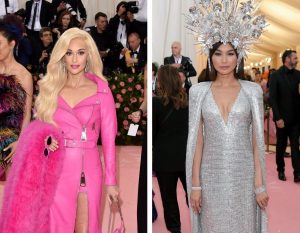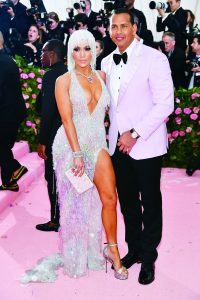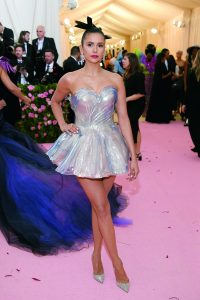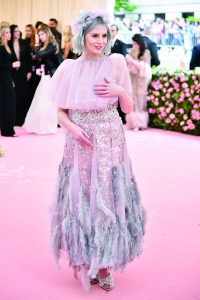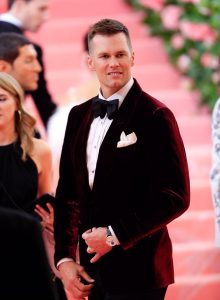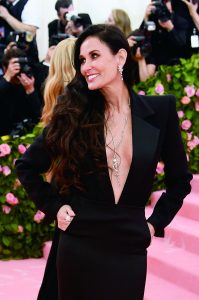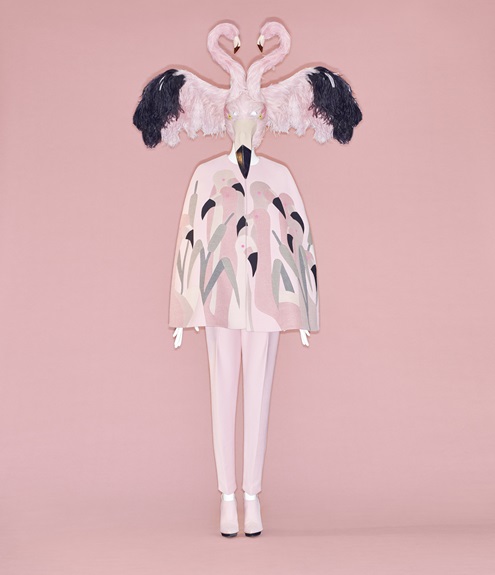November 22, 2021
by Carla Hay
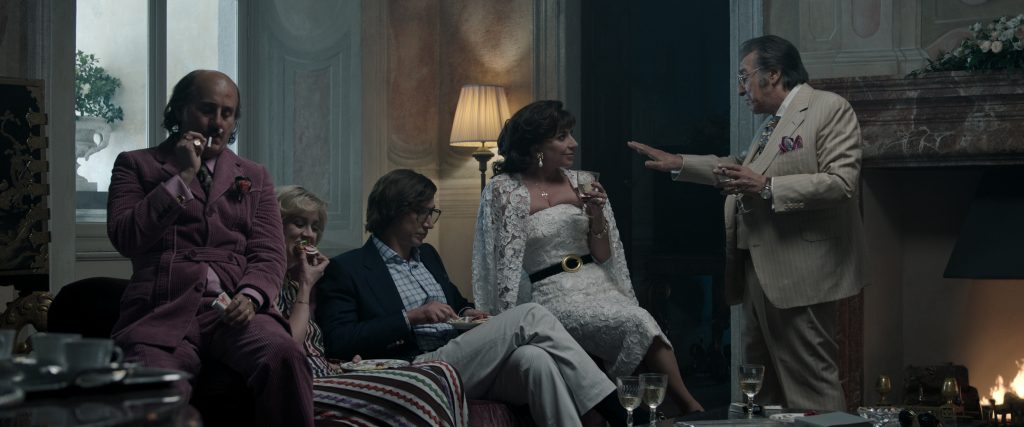
Directed by Ridley Scott
Culture Representation: Taking place from 1978 to 1997, mostly in Italy and New York City, the dramatic film “House of Gucci” features a predominantly white cast of characters (with one Latina and a few Asians) representing the middle-class and wealthy.
Culture Clash: After middle-class Patrizia Reggiani marries into the wealthy Gucci family, family members start to battle over the Gucci empire of luxury goods, resulting in one of the family members getting murdered.
Culture Audience: “House of Gucci” will appeal primarily to fans of the movie’s star-studded cast, the Gucci brand and tawdry true crime movies.

Just like a fake Gucci item, “House of Gucci” is a tacky sham that quickly falls apart. Don’t be fooled into thinking this is a high-quality movie, just because of the celebrity names and Oscar pedigrees of the movie’s headlining stars and director. The movie looks good, when it comes to production design, costume design, makeup and hairstyling. But the screenplay is atrocious, the acting is uneven, and director Ridley Scott helmed “House of Gucci” like it’s an idiotic melodrama made for mediocre television, but with a much higher budget than most TV-movies will ever have. (“House of Gucci” even has some laughably bad freeze-frame shots as lazy ways of putting emphasis on a particular emotion.)
It’s all the more reason for viewers to be disappointed that several Oscar winners and Oscar nominees have stepped into this “smoke and mirrors” cesspool of a movie. We all know that the fashion industry is all about image and how someone looks on the outside. That doesn’t mean that a movie about the Gucci empire’s biggest scandal needs to be shallow and superficial too.
The weakest link in “House of Gucci” is the screenplay, written by Becky Johnston and Roberto Bentivegna. They adapted the screenplay from Sara Gay Forden’s 2000 book “The House of Gucci: A Sensational Story of Murder, Madness, Glamour and Greed.” The “House of Gucci” movie is slipshod in certain details, by getting some basic facts wrong about this notorious murder case. And many parts of this movie are surprisingly dull. Don’t expect there to be any riveting scenes of a murder trial in “House of Gucci.” There aren’t any. There’s a poorly written, anti-climactic courtroom scene that’s rushed into the movie.
The Gucci murder case involved a complex group of real-life people, who are mostly reduced to caricatures in the movie. However, a few of the “House of Gucci” cast members make the film watchable because of their performances: Lady Gaga, Jeremy Irons and Jared Leto. They stand out for completely different reasons.
Lady Gaga is compelling to watch as the scheming Patrizia Reggiani, who was at the center of the Gucci scandal because Reggiani was convicted of masterminding a murder plot. The details of the Gucci murder case are well-documented, but in case anyone reading this review doesn’t know anything about the case before seeing the movie, this review won’t reveal who was murdered. (Although it’s pretty obvious, when you consider who would have to die for Reggiani to inherit a large share of the Gucci fortune.)
Lady Gaga’s performance as Patrizia Reggiani takes a deep dive into campiness, occasionally comes up for air in earnestness, and sometimes lounges around in limpness. Overall, Lady Gaga has the type of on-screen magnetism that even when Patrizia is doing awful things, it’s with the type of villainous charisma where you know this character is capable of convincing some people that she did very bad things for very good reasons.
A campy performance isn’t necessarily a problem if the rest of the actors are on the same wavelength. Unfortunately, “House of Gucci” director Scott failed to bring a cohesive tone to this movie. Other “House of Gucci” actors give performances that are not campy at all but come across as if they truly believe this is a serious, artsy drama worthy of the highest accolades in the movie industry in every top-level category.
That’s the kind of performance that Adam Driver gives in “House of Gucci,” where he portrays Patrizia’s beleagured husband Maurizio Gucci. Maurizio met Patrizia when he was a law student and had no intention of joining the family business. Driver’s portrayal of Maurizio has the type of personality transformation that actors usually relish.
Maurizio goes from being mild-mannered and easily manipulated when he meets Patrizia while he was in law school to becoming a ruthless and recklessly spending businessman who casts Patrizia aside when he decides to move in with his mistress Paola Franchi (played by Camille Cottin) and divorce Patrizia. Their divorce became final in 1994.
“House of Gucci” makes it look like Maurizio abandoned not only Patrizia but essentially neglected their daughter Alessandra after the divorce. The three actresses who portray Alessandra in “House of Gucci” are Nicole Bani Sarkute (Alessandra at 3 years old); Mia McGovern Zaini (Alessandra at 9 years old); and Clelia Rossi Marcelli (teenage Alessandra).
In reality, Patrizia and Maurizio had two children together: daughters Alessandra (born in 1976) and Allegra, born in 1981. The erasure of Allegra from the movie is just one of the many details that “House of Gucci” gets wrong. The movie also changes the timeline of when Patrizia and Maurizio met and got married. In the beginning of the movie, Patrizia meets Maurizio in 1978. In real life, Patrizia and Maurizio met in 1970 and got married in 1972.
In the “House of Gucci” movie version of Patrizia’s life in 1978, she was working as an office manager for her stepfather’s truck transportation business in Milan, Italy. Patrizia and Maurizio meet at a nightclub party of one of his friends. Maurizio is standing behind the bar, and Patrizia mistakes him for the bartender, so she asks him to fix her a drink. Maurizio thinks that she’s confident and sexy. He tells her that she reminds him of Elizabeth Taylor.
Patrizia seems much more interested in Maurizio when he mentions that his last name is Gucci. Patrizia asks Maurizio if he wants to dance. He says no. The scene then cuts to Patrizia and Maurizio dancing together on the dance floor. Patrizia’s persuasive personality sets the tone for much of their relationship.
It seems like the “House of Gucci” filmmakers decided to change this couple’s courtship to take place in the late 1970s solely for the purpose of having disco music in the movie’s scenes that depict the early years of their relationship. After all, Lady Gaga looks better twirling or slow dancing on a 1978 dance floor where there’s a disco ball and Studio 54-type of partiers, instead of a scene at a 1970 party that would probably have to be staged with a bunch of rich-looking hippies.
Therefore, the “House of Gucci” soundtrack serves up its share of disco music, such as Donna Summer’s “I Feel Love,” Donna Summer’s “Bad Girls,” Blondie’s “Heart of Glass” and Donna Summer’s “On the Radio.” Later, when the movie’s timeline goes into the 1980s, the soundtrack features songs such as the Eurythmics hits “Sweet Dreams (Are Made of This)” and “Here Comes the Rain Again.” The soundtrack songs often blare in “House of Gucci” in music-video-styled sequences that further cheapen the look of the movie.
The first sign that Patrizia is willing to do whatever it takes to get what she wants is when she stalks Maurizio on campus at his law school. She follows him into a library and pretends to “coincidentally” run into him again. This scene is like something right out of a Lifetime movie. Maurizio has no idea that he’s being targeted, so he goes along with Patrizia’s seduction and is eventually convinced that their relationship is true love.
Irons gives an understated and believable performance as Rodolfo Gucci, Maurizio’s widower father, who is the only Gucci family member who holds on to his dignity in this movie. Rodolfo is immediately suspicious of Patrizia and her intentions for his only child. Rodolfo doesn’t come right out and use the words “gold digger” when he warns Maurizio not to marry Patrizia, but Rodolfo expresses his concerns that Patrizia is not a woman of substance and that she seems to be latching on to Maurizio because of the Gucci family fortune.
Even though Rodolfo vehemently disapproves of Patrizia, it turns out that Rodolfo and Patrizia actually agree on something: They both think that Maurizio should go into the Gucci family business. However, Maurizio’s refusal to follow his father’s wishes leads to him being estranged from Rodolfo for a while.
Maurizio is kicked out of the family home and cut off from his family’s financial support. With nowhere else to go, Maurizio moves in with Patrizia and her parents. Maurizio gets a job working for Patrizia’s stepfather Fernando (played by Vincent Riotta), who’s depicted in the movie as someone who engages in shady business practices.
To put an emphasis on how much Maurizio is estranged from his former life, when Patrizia and Maurizio get married in a church, the movie makes a point of showing that the pews on the bride’s side of the aisle are filled with her family members and friends, while the pews on the groom’s side of the aisle are almost empty. George Michael’s 1987 song “Faith” is played in the movie’s soundtrack after Patrizia and Maurizio exchange vows and walk happily out of the church. This soundtrack choice is an example of more of the movie’s carelessness with details, because the wedding took place years before “Faith” was released and before Michael was even a pop star.
Meanwhile, Rodolfo’s older brother Aldo Gucci (played by Al Pacino, hamming it up in the type of moody roles he’s been doing recently) doesn’t trust Aldo’s dimwitted son Paolo (played by Leto) to be in charge of any part of the family business. Aldo reaches out to Maurizio to come back to the family fold, but Maurizio still hesitates. Patrizia eventually joins forces with Aldo to persuade Maurizio to reconcile with his family and become part of the Gucci business empire. Maurizio eventually agrees, because at this point in his life, he still wants to please Patrizia. For a while, Patrizia and Maurizio made their home base in New York City during Maurizio’s rise in the Gucci business.
More scheming and manipulations ensue, exactly like how you expect them to play out in a movie that is plagued with clumsy clichés. Patrizia and Maurizio are not shown having any meaningful conversations that are not about his family, money or business. In other words, the movie falls short of convincing viewers that Maurizio and Patrizia had a deep emotional love that would make him blind to her gold-digging ways.
Maurizio and Patrizia have a passionate sex life in the beginning of their relationship, so the movie implies that lust, not love, was what really brought this couple together. The sex scenes in “House of Gucci” aren’t very sexy because they look more like parodies of soap-opera-styled sex. Items on tables are shoved aside and crash on the floor to make room on the table for whatever sex act occurs. Any vigorous thrusting doesn’t look erotic but looks more like someone having a robotic workout routine at a gym. And the orgasms sound very fake.
It’s not much of a surprise that “House of Gucci” is a very “straight male gaze” movie where only women’s nude private parts are shown, not men’s nude private parts. And speaking of people in “House of Gucci” in various states of undress, this movie has a semi-obsession with Patrizia being seen in bathtubs or saunas. Apparently, the filmmakers want viewers to think that life is supposed to be more luxurious if you take baths instead of showers.
The supporting characters in “House of Gucci” are either over-the-top ridiculous (Salma Hayek as Giuseppina “Pina” Auriemma, a self-described psychic who befriends Patrizia), or bland as bland as can be (Jack Huston as Gucci financial advisor Domenico De Sole; Reeve Carney as fashion designer Tom Ford) with no intriguing personalities. Pina is a stereotypical con artist who gives vague predictions to Patrizia (“I see a big fortune coming your way”) and mystical-sounding advice, such as telling Patrizia that Patrizia should wear more red for “protection” and more green for “cleansing.”
The fashion industry is a mere backdrop to the betrayals and lies that usually originate from Patrizia and spread like a virus to other members of the Gucci family. For example, “House of Gucci” wastes an opportunity to give a fascinating insider’s look at the Gucci empire. Instead, the movie gives trite portrayals of the massive reinvention that the Gucci brand underwent from the 1970s to the 1990s. The movie serves up a fast-food version of what happened on the business side of the Gucci story.
“House of Gucci” unrealistically makes it look like it was only Patrizia who had the business sense to tell the family in the 1980s that it was devaluing the Gucci name by licensing the brand to cheap-quality merchandise, and that they needed to go back to Gucci being synonymous with luxury. The Gucci brand was then repositioned as “hip/trendy” (not old-fashioned) luxury. For all of her supposed business skills, Patrizia isn’t actually showing doing any real work as a so-called Gucci powerhouse. According to this movie, all she seems to be good at doing is telling people what to do.
The “House of Gucci” role of fashion designer Ford, a native of Texas who is credited with helping further reinvent the Gucci brand in the 1990s, is literally a walk-on role: The most memorable things that he does in the movie is give the traditional end-of-show designer stroll on a runway after showing a collection, and when Ford reads a newspaper article that praises him, he walks out of the room to say that he can’t wait to call his mother.
At no point in the movie is anyone in the Gucci empire shown having a strong relationship with Ford, even though he was a driving force at Gucci, where he worked from 1990 to 2004, with most of those years spent as Gucci’s creative director. There are some hints that De Sole had his own agendas and ambitions, but the character is written in a completely boring and hollow way. Unless you’re a fashion aficionado who knows about De Sole and his further ascent in the Gucci empire, you might have a hard time remembering his name after watching this movie.
“House of Gucci” is also problematic in how it portrays women, because the three female characters with the most prominent speaking roles are either villains (Patrizia and Pina) or a mistress (Paola). Vogue magazine editorial executive Anna Wintour (played by Catherine Walker), actress Sophia Loren (played by Mãdãlina Ghenea) and Paolo’s wife Jenny Gucci (played by Florence Andrews) have meaningless cameos in “House of Gucci.” Even back in the 1970s to 1990s, when this movie takes place, women were so much more important in the fashion industry than what “House of Gucci” makes it look like.
Out of all the portrayals of the Gucci men in “House of Gucci,” Leto’s performance as Paolo is the flashiest one. Much of the performance’s standout qualities have to do with the top-notch prosthetics that Leto wears to make him look like a completely different person who is heavier and older than Leto’s real physical appearance. However, Leto does show some actor panache by having an amusing Italian accent, and he plays Paolo’s buffoon role to the hilt, bringing some intentional comedic moments.
Leto’s performance is only marred by some silly-looking scenes, such as when Paolo does an awkward dance of jubilation with Patrizia when she deceives aspiring fashion designer Paolo into thinking that his horrendous fashions are fabulous and worthy of being part of the Gucci brand. It’s the type of scene that looks like something Steve Martin and Dan Aykroyd would’ve rejected for their Two Wild and Crazy Guys act on “Saturday Night Live.” Paolo’s words and actions get more cartoonish as the movie goes along. A low point is when Paolo urinates on a Gucci scarf in a fit of anger.
Unfortunately, the best performance efforts by the “House of Gucci” cast members can’t overcome the very cringeworthy screenplay that ruins this movie. In one scene, when Patrizia and Maurizio have an argument, she chokes up with tears and says: “I had no idea I married a monster.” He replies coldly, “You didn’t. You married a Gucci.” In another scene, Pina snarls at someone, “Don’t fuck this up, ’cause I’ll put a spell on you!” In another scene, Paolo says, “Never confuse shit with chocolate. They may look the same, but they’re very different. Trust me, I know!”
The Paolo character might want to warn people not to confuse defecation with chocolate, but viewers should be warned not to confuse “House of Gucci” with being a superb film. For a movie that’s supposed to be about a haute couture/luxury fashion brand, it wallows in the muck of cheap gimmicks, sloppy screenwriting and a lack of self-awareness about how horrendous the worst parts are. The end result is a tawdry mess. And you can’t erase the stink from that.
Metro Goldwyn Mayer Pictures will release “House of Gucci” in U.S. cinemas on November 24, 2021. “House of Gucci” is set for release on digital and VOD on February 1, 2022. The movie’s release date on Blu-ray and DVD is on February 22, 2022.

